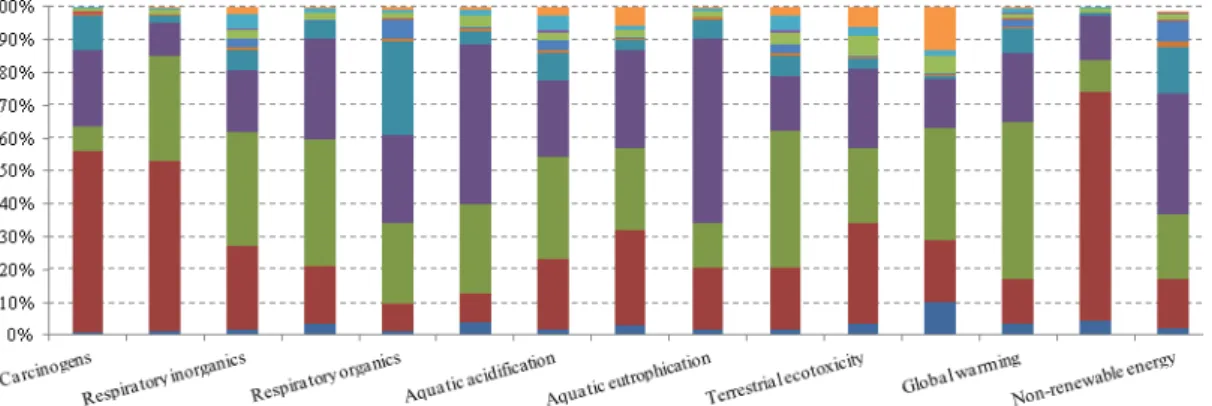First International Conference on Bio-based Building Materials June 22nd - 24th 2015 Clermont-Ferrand, France
718
COMPARATIVE ENVIRONMENTAL LIFE CYCLE ASSESSMENT OF
VEGETATIVE ROOFS: A CASE STUDY FROM LEBANON
Makram El Bachawati1, Rima Manneh1, Thomas Dandres2, Carla Nassab3, Henri El Zakhem1, Rafik Belarbi4 1
University of Balamand, Chemical Engineering Department, El Koura, North Lebanon, Lebanon 2CIRAIG, Chemical Engineering Department, École Polytechnique of Montreal, P.O. Box 6079, Montreal,
Quebec, H3C 3A7, Canada
3 The United Nations Development Program (UNDP), CEDRO project, Beirut, Lebanon 4
University of La Rochelle, Laboratory of Engineering Science for Environment LaSIE, 17042 La Rochelle Cedex 1, Michel Crépeau Avenue, La Rochelle, France
E-mail contact: makram.bachawati@balamand.edu.lb
1 INTRODUCTION
A vegetative roof is a "roofing system that promotes the growth of plants on a rooftop" [1]. In addition to embellishing the traditional roof surface, vegetative roofs offer many advantages. They protect the roof assembly from solar radiation and hail damage, hence reducing temperature fluctuations in spaces beneath it ranging from 1 to 3 floors, which implies a reduction in the building energy consumption [2]. If installed on broad surfaces, vegetative roofs might also attenuate the urban heat island effect [3]. Furthermore, from a water management perspective, vegetative roofs could be a useful tool to capture the water in the substrate, reducing water runoff and managing flooding during heavy rains. Lebanon is a Middle Eastern country that lacks a clear sustainability plan as well as an infrastructure update and management, leading to road floodings in urban area amongst other things. Therefore, the installation of vegetative roofs could be an interesting option. So far, a few extensive green roofs have been installed in Lebanon. In order to determine if vegetative roofs are truly superior to traditional roofs for Lebanon, a Life Cycle Assessment (LCA) is done, comparing the case study at hand, an 834 sqm vegetative roof at the Lebanese Central Bank, with three other roofs: intensive, reflective and traditional.
2 MATERIALS AND METHODS 2.1 Goal and Scope
The goal of this study is to compare the life cycle environmental impacts of an existing extensive roof to three fictitious roofs (intensive, reflective and traditional gravel-asphalted roofs). The extensive green roof, installed at the Lebanese Central Bank in Hamra region, is the first to be installed in Lebanon of this area. The SimaPro 8.0 [4] software is used to do the LCA modelling, while the IMPACT 2002+ methodology [5] is used to evaluate the environmental impacts.
The functional unit is: “The implementation of a roofing system for a surface of 834 sqm and for 45 years”.
2.2 Life cycle inventory
The traditional gravel-asphalted roof is a modified bituminous membrane roof. It is formed of bricks, steel and ready concrete. The lifespan of such a conventional roof is considered 15 years. The reflective roof consists of a flat roof, protected by a layer of isolation and a reflective membrane, with a lifespan of 30 years. The components of the traditional gravel-asphalted roof and the reflective roof were supplied from local manufacturers, while the specifications were provided by some technicians and civil engineers. The extensive green roof is made of the following layers: water proofing membrane, thermal insulation layer, root resistant barrier, protection mat, drainage layer, filter sheet, growing medium, and vegetation layer (the latter is not considered in the study). The substrate of the studied extensive vegetative roof is 150 mm in depth and its lifespan is fixed at 45 years. The intensive green roof has the same lifespan and involves the same layers as the extensive roof, but the depth of its substrate is 1200 mm. The components of the vegetative roofs were shipped from a German manufacturer, while their specifications were gathered from the United Nations Development Program,-CEDRO project.
3 RESULTS: LIFE CYCLE IMPACT
ASSESSMENT
Figure 15 shows the contribution of the different components of an extensive roof to the potential environmental impacts, while Figure 16 indicates the comparative LCA of the considered roofs. The common parts to the roofs are not included.
Results indicate that, for the studied extensive green roof, the waterproof membrane and the substrate layer are the highest contributors to the environmental impacts. This is due to the amount of
ICBBM 2015
719 polystyrene used in the waterproof membrane and the quantity of perlite used in the substrate layer. As for the comparative LCA, results show that, for all impact categories, the extensive roof is better than the other roofs. This is because, for the same
lifespan (45 years), the amount of materials used for the traditional gravel-asphalted and reflective roofs is higher than the amount used for an extensive roof.
Figure 15: Life cycle assessment of ‘1p’ extensive green roof
Figure 16: Comparative LCA of ‘1p’ extensive green roof and ‘3p’ traditional roof
4 CONCLUSION
This study indicated that, when comparing the four types of roofs, vegetative roofs are a better option from an environmental perspective. However, it should be noted that this case study is limited to the roof type (flat or sloped) and the geographic location of the study. Future research is to be performed on the effect of different substrate composition, water retention and energy consumption.
5 REFERENCES
[1] Liu K-Y, Baskaran A. 2005. Using Garden Roof Systems to Achieve Sustainable Building Envelopes. Construction Technology Update 65
[2] Christian J.E, Petrie T.W. 1996. Sustainable Roofs with Real Energy Savings. Proceedings of the Sustainable Low-Slope Roofing Workshop, Oak Ridge, Tennessee, p.99.
[3] Peck S.W, Callaghan C, Kuhn M.E, Bass B. 1999. Vegetative backs from Vegetative Roofs: Forging a New Industry in Canada. Canadian Mortgage and Housing Corporation Research Report.
[4] Goedkoop M, Oele M. 2013. SimaPro User Manual. The Netherlands: PRe´ Consultants B.V. [5] Jolliet O, Margni M, Charles R, Humbert S, Jérôme P, Rebitzer G, and Rosenbaum R. 2003. IMPACT 2002+: A new life cycle impact assessment methodology. International Journal of Life Cycle Assessment, 8(6), 324-330.
